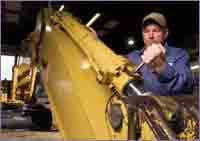|
|
Sunland Construction expects its operating divisions to work as independent companies—accountable to their individual financial statements, yet observing corporate policies and procedures. But division managers lacked the human resources necessary to manage what was often the largest cost line in their budgets.
"Each division (there are 11 working in 38 states) is responsible for its own profit and loss as though it was a separate company," says Dennis Sullivan, corporate equipment manager. "But equipment revenue and expense wasn't being handled by the divisions. Equipment cost control wound up with the corporate equipment division and corporate finance people."
The corporate equipment division sets rates, directs policies and procedures, and consolidates company purchasing power. It is intended to monitor equipment cost and performance across the company and consult with the divisions on individual machine decisions.
"Division managers and project superintendents have all sorts of other things to do to keep projects running," says Sullivan. "To discuss repairs on one of their assets, or acquisition or disposal took up valuable time in their day."
He convinced Sunland to establish the position of division equipment coordinator. These coordinators are in place at seven operating divisions, and they're responsible for directing and monitoring maintenance, day-to-day rental, and all other hands-on equipment issues at the division level.
"They can prioritize repairs and maintenance, and they assess the costs of various options as one of their primary functions," says Sullivan. "The division manager, and the company, get a quicker, closer look at equipment costs so we're all able to do a much better job managing them."
The corporate equipment division purchases anything worth more than $2,500, but the machines are specified with direct input from the division where they will be assigned. Repairs that cost more than $2,000 are discussed at the corporate level. Through the internal rate structure, all the costs and income from each machine are passed back to its operating division.
It has been about four years since division equipment coordinators were hired.
"One of the biggest cost savings comes from a reduction in equipment repairs, mostly due to improved preventive maintenance," says Sullivan. "They're catching oil changes when they're supposed to be caught, eliminating repairs that result from lack of maintenance."
And with somebody managing machine utilization at the divisions, Sunland was able to organize a Utilization Team.
"There's an e-mail list that includes all of the division equipment coordinators, division managers, and anyone else who's interested in equipment," he explains. "Before a machine is rented or we get into the acquisition process, an e-mail goes out to the Utilization Team asking if there's something like it available somewhere else."
Paying attention to utilization has improved it. Annual hours are rising for Sunland's largest groups of equipment, such as hydraulic excavators, dozers, sidebooms, backhoe-loaders, and light- and medium-duty trucks.
More importantly, improved maintenance and rising utilization are driving equipment rates down.
"One example is the 30- to 80-horsepower trenchers that our North Carolina division uses," says Sullivan. "They have more than 70 trenchers—they install a lot of gas distribution line. Over the last three years, we've lowered our internal rates on those trenchers three times because maintenance and utilization keep improving."
Rates on 70,000-pound excavators increased $2 two years ago—a refinement that was necessary to profitable bidding.
"After a couple years of monitoring costs and annual hours, we were convinced that utilization was up where it should be—the costs were just exceeding income," says Sullivan. "Our rates hadn't been adjusted in several years. We had to get current with them."
Fleet data supplied by the equipment module of the Sunland accounting system—Dexter & Chaney's Forefront—has been crucial to managing equipment during Sunland's explosive growth. Over the past five years, acquisition and organic growth have nearly doubled company revenue. Fleet size has doubled.
Inevitably, though, it's people who must make informed decisions. And Sunland has learned that independent operating divisions make more profitable equipment choices when there's teamwork between division staff close to where machines are working and corporate people who have a fleet-wide perspective.
"Our division equipment coordinators are usually either top mechanics who are great at dealing with maintenance and repair but who are not so strong managing a fleet, or they are great managers who can handle the paperwork but don't know maintenance as well," says Sullivan. "Our corporate equipment maintenance supervisor, Jody Monceax, and I are here to assist them in maintenance and management areas—to support whatever they need, and to make sure that their experience is shared throughout the company."
 Mechanic Bill Laughlin checks the bucket-cylinder head fitting on one of Sunland's hard-working excavators.
Mechanic Bill Laughlin checks the bucket-cylinder head fitting on one of Sunland's hard-working excavators.



